Haidhausen & Lehel
Haidhausen is hip, eclectic and leagues away from its 19th-century working-class roots. Major gentrification since the late 1970s has made the district desirable for artsy professionals and urban types. It’s light on sights but a lovely place for aimless wandering. Lehel (lay-hl) has the second-highest concentration of museums after the art nexus in Maxvorstadt. It’s the oldest Munich suburb, having been absorbed into the city in 1724, and its charismatic warren of quiet streets is lined with late-19th-century buildings.
The place to start a day in Haidhausen and Lehel is the Deutsches Museum, by far the area’s main attraction. Half a day is just about enough to see most of the technical wonders on display here before grabbing lunch and heading to Villa Stuck, one of Europe’s finest art nouveau homes, and Sammlung Schack for a dose of Romantic art. In the evening take a wander through the atmospheric streets of Lehel before ending the day at Wirtshaus in der Au for a meat and dumpling combo washed down with a Munich beer or two.
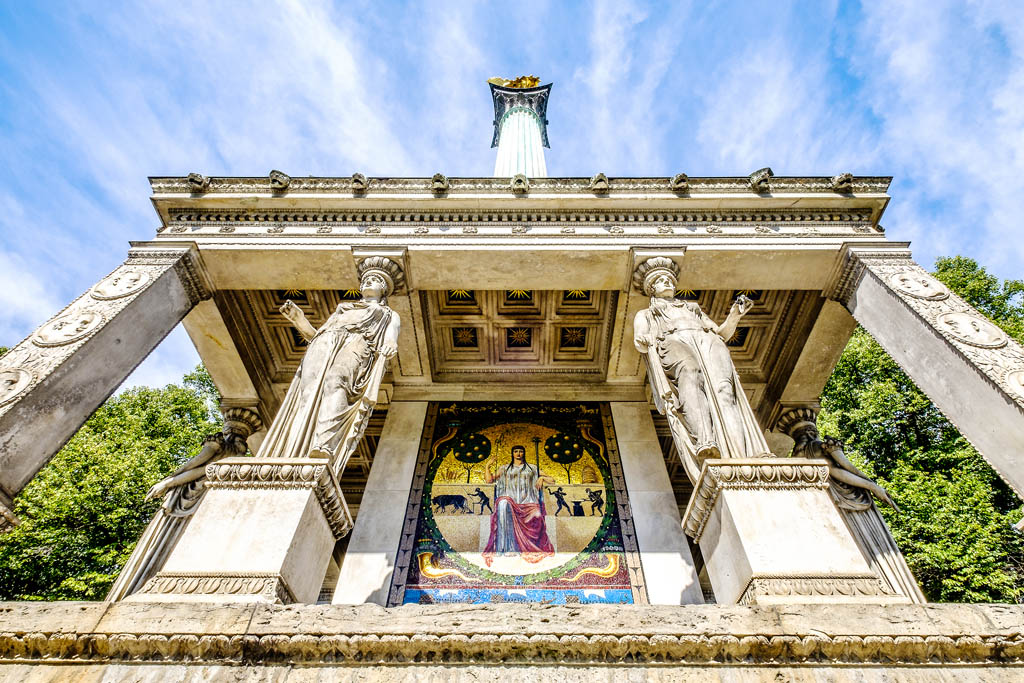
Getting There & Around
![]() b For Lehel the U-Bahn station of the same name is the place to alight. Prinzregentenplatz and Max-Weber-Platz serve Haidhausen.
b For Lehel the U-Bahn station of the same name is the place to alight. Prinzregentenplatz and Max-Weber-Platz serve Haidhausen.
![]() j The Deutsches Museum has its own tram stop. s 16 and 19 serve Lehel while trams 13, 15, 18 and 37 run through Haidhausen.
j The Deutsches Museum has its own tram stop. s 16 and 19 serve Lehel while trams 13, 15, 18 and 37 run through Haidhausen.
Top SightsDeutsches Museum
If you’re one of those people for whom science is an unfathomable turn-off, a visit to the Deutsches Museum might just show you that physics and engineering are more fun than you thought. Spending a few hours in this temple to technology is an eye-opening journey of discovery, and the exhibitions and demonstrations will be a hit with young, sponge-like minds. You could spend a whole day wandering the museum’s halls – many do.
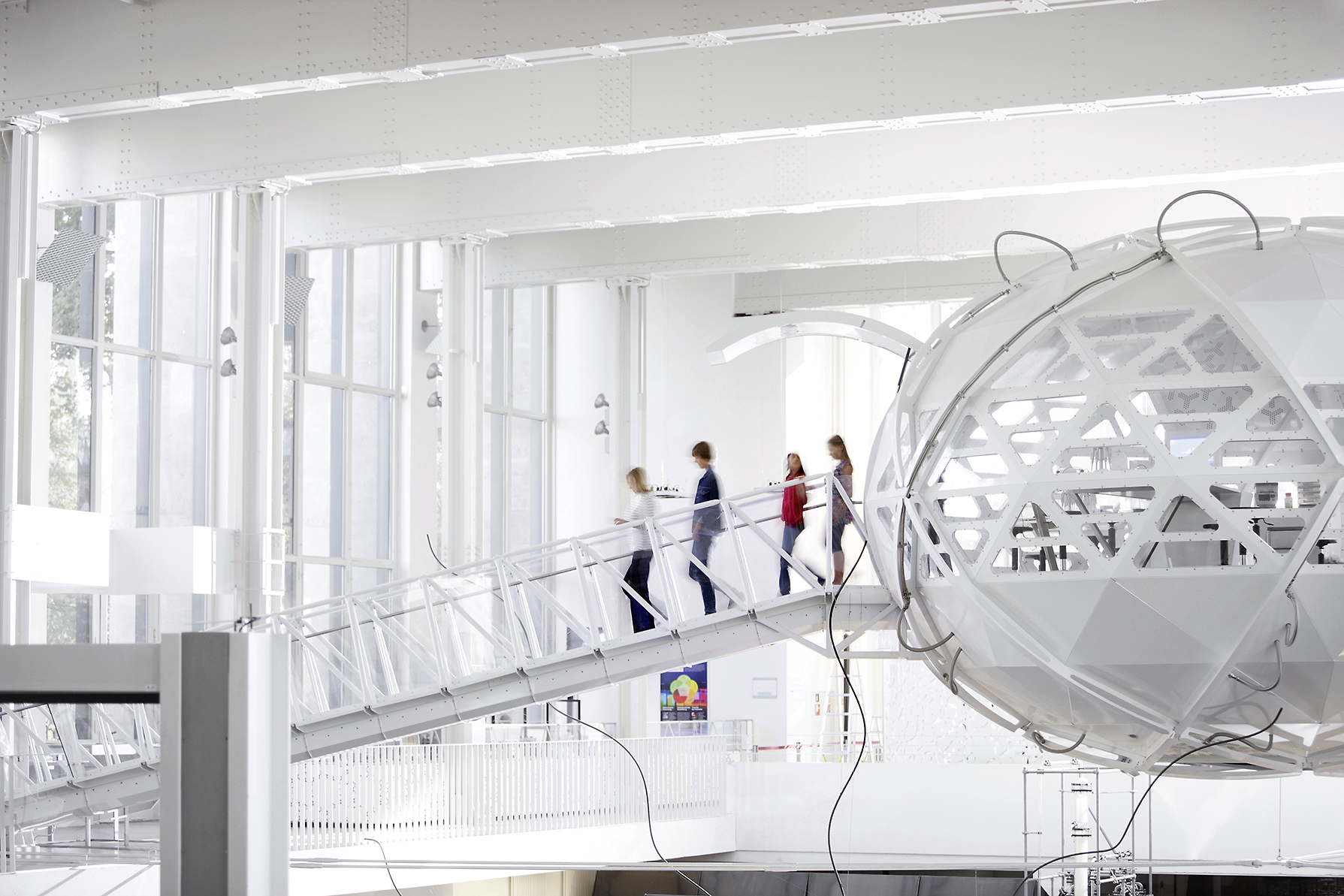
MAP GOOGLE MAP![]() %089-217 9333
%089-217 9333
www.deutsches-museum.de
Museumsinsel 1
adult/child €12/4![]() h9am-5pm
h9am-5pm![]() jDeutsches Museum
jDeutsches Museum
Museum on an Island
Occupying the Museumsinsel (Museum Island) in the River Isar, this unrivalled museum could keep you occupied all day, especially with inquisitive kids in tow – the collections boast 100,000 items, either displayed or in storage. There are tons of interactive displays (including glass blowing and paper making), live demonstrations and experiments, model coal and salt mines, and engaging sections on cave paintings, geodesy, microelectronics and astronomy. In fact, it can be pretty overwhelming after a while, so it’s best to prioritise what you want to see.
Kinderreich
The place to entertain children aged three to eight is the fabulous Kinderreich, where 1000 activities await, from a kid-size mouse wheel to interactive water fun. Get the littlies to climb all over a fire engine, build things with giant Lego, construct a waterway with canals and locks, or bang on a drum all day in a (thankfully) soundproof instrument room.
Verkehrszentrum
The museum’s second branch, the Verkehrszentrum (Transport Museum; www.deutsches-museum.de/verkehrszentrum; Am Bavariapark 5; adult/child €7/3; ![]() h9am-5pm;
h9am-5pm; ![]() XTheresienwiese), in the west of the city centre, is an ode to the Bavarian obsession with getting around. The collections explore the ingenious ways humans have devised to transport things, including each other. From the earliest automobiles to famous race cars and the high-speed ICE trains, a visit is a virtual trip through transport history.
XTheresienwiese), in the west of the city centre, is an ode to the Bavarian obsession with getting around. The collections explore the ingenious ways humans have devised to transport things, including each other. From the earliest automobiles to famous race cars and the high-speed ICE trains, a visit is a virtual trip through transport history.
The exhibit is spread over three historic trade-fair halls near Theresienwiese – each with its own theme: Public Transportation, Travel, and Mobility & Technology – and is a fun place even if you can’t tell a piston from a carburettor.
Walking TourA Stroll Through Haidhausen
The suburb of Haidhausen actually predates the Altstadt by a few hundred years and was for centuries a poor area where labourers and fresh arrivals from Bavaria’s hinterland would set up shop. Today it is a tranquil area of residential streets, neighbourhood businesses and dog-walking locals, but some reminders of the grittier past remain.
Walk Facts
Start Mariahilfplatz; ![]() j18
j18
End Wiener Platz; ![]() XMaz-Weber-Platz
XMaz-Weber-Platz

1Mariahilfplatz
Tram 18 drops you off at Mariahilfplatz, the venue for some of Munich’s dult festivals (traditional fairs with rides and food). Passing by the red-brick Mariahilfkirche you’ll come to the Auer Mühlbach, a fast-moving stream that once powered mills. You can follow it to the next stop through leafy residential areas, one on an island.
2Müller’sches Volksbad
Munich’s most famous swimming pool (MAP; www.swm.de; Rosenheimer Strasse 1; adult/child €4.50/3.40; ![]() h7.30am-11pm;
h7.30am-11pm; ![]() jAm Gasteig) is an exquisite art nouveau affair that first opened its doors in 1901. It’s one of Europe’s most attractive swimming baths and a dip here under the ornate stuccoed ceiling is a real treat. Despite the period look, it boasts 21st-century pool and sauna technology.
jAm Gasteig) is an exquisite art nouveau affair that first opened its doors in 1901. It’s one of Europe’s most attractive swimming baths and a dip here under the ornate stuccoed ceiling is a real treat. Despite the period look, it boasts 21st-century pool and sauna technology.
3Muffatwerk
The Biergarten Muffatwerk is a kind of cooler version of the traditional Munich beer garden: reggae instead of oompah, vegetarian plates instead of pig-knuckle platters. There’s regular live music in the evenings and a great vibe all day long.
4Gasteig
You cannot fail to notice the Gasteig, a mammoth building in brick and glass rising confidently over Am Gasteig and Rosenheimer Strasse. It’s one of southern Germany’s top concert venues attracting huge international acts. It’s also home to the Münchner Philharmoniker.
5Herbergsmuseum & Kriechbaumhof
In Preysingstrasse, the Herbergsmuseum is a tiny former worker’s cottage that has been done up as it would have been when it was inhabited by a labourer’s family in the 19th century. Opposite, the conspicuous all-timber Kriechbaumhof looks like it’s been teleported from the Alps.
6Haidhausen Cemetery
The austere, slender spire of the Church of John the Baptist rises above Kirchenstrasse and the adjoining and somewhat overgrown walled cemetery, one of Munich’s most attractive, with rows of tombs in different artistic styles. Its most famous resident is Austrian actor Kurt Zips.
7Wiener Platz
So called as it marked the start of the road to Vienna, busy Wiener Platz is known for its daily gourmet market, which has been held since 1901 under a supersize maypole. Tiny cafes and kiosks sell everything from fish mains to chocolate to sausages, and it’s a great place to lunch or snack.
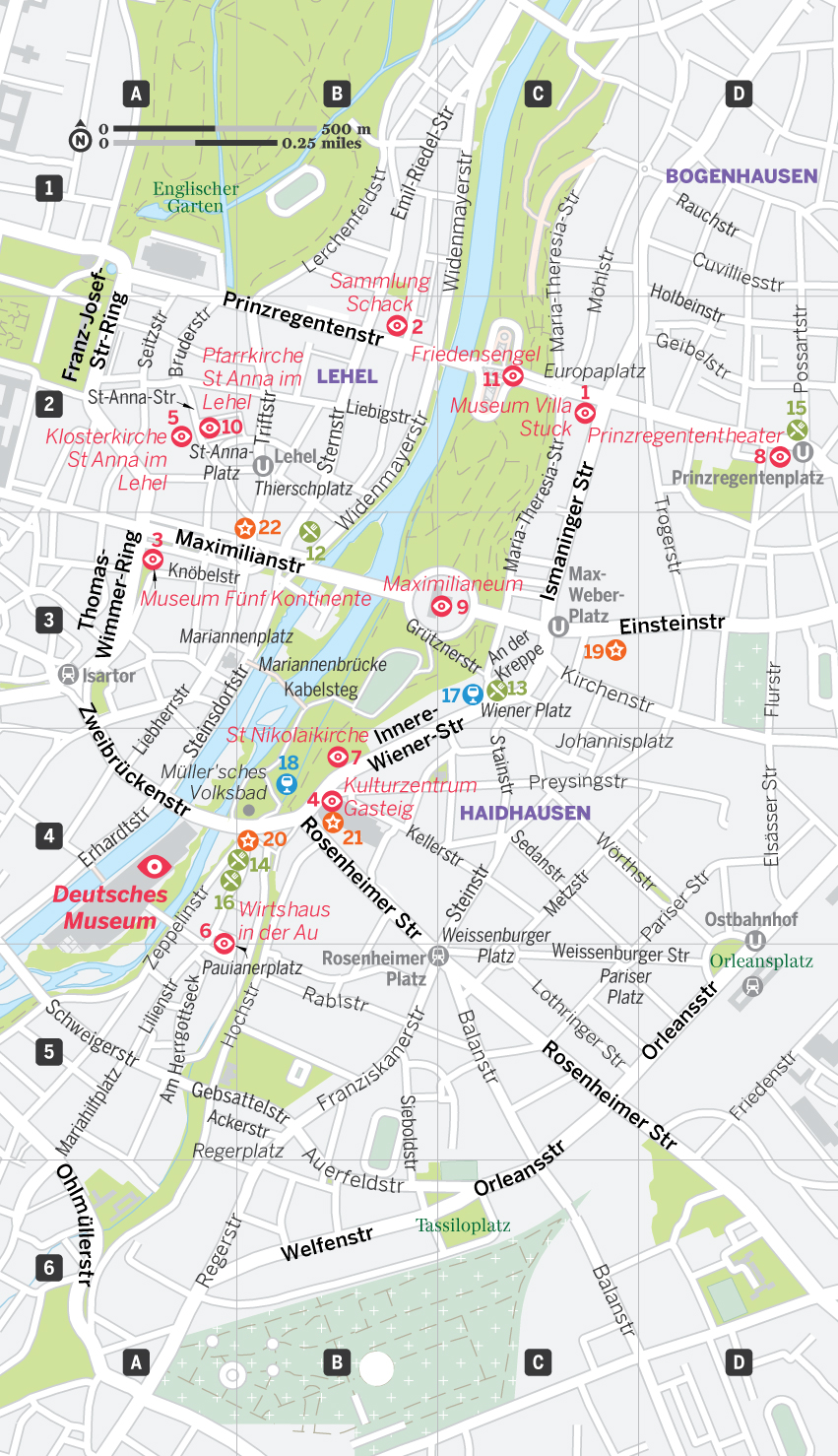
Sights
1Museum Villa Stuck MUSEUM
Around the turn of the 20th century, Franz von Stuck was a leading light on Munich’s art scene, and his residence is one of the finest Jugendstil homes you’re ever likely to see. Stuck came up with the intricate design, which forges tapestries, patterned floors, coffered ceilings and other elements into a harmonious work of art. Today his glorious pad is open as a museum with changing exhibitions. (![]() %089-455 5510; www.villastuck.de; Prinzregentenstrasse 60; adult/concession €9/4.50;
%089-455 5510; www.villastuck.de; Prinzregentenstrasse 60; adult/concession €9/4.50; ![]() h11am-6pm Tue-Sun;
h11am-6pm Tue-Sun; ![]() gFriedensengel/Villa Stuck)
gFriedensengel/Villa Stuck)
1Sammlung Schack MUSEUM
Count Adolf Friedrich von Schack (1815–94) was a great fan of 19th-century Romantic painters such as Böcklin, Feuerbach and von Schwind. His collection is housed in the former Prussian embassy, now the Schack-Galerie. A tour of the intimate space is like an escape into the idealised fantasy worlds created by these artists. (www.sammlung-schack.de; Prinzregentenstrasse 9; adult/concession €4/3; ![]() h10am-6pm Wed-Sun;
h10am-6pm Wed-Sun; ![]() gReitmorstrasse/Sammlung Schack)
gReitmorstrasse/Sammlung Schack)
1Museum Fünf Kontinente MUSEUM
A bonanza of art and objects from Africa, India, the Americas, the Middle East and Polynesia, the State Museum of Ethnology has one of the most prestigious and complete ethnological collections anywhere. Sculpture from West and Central Africa is particularly impressive, as are Peruvian ceramics, Indian jewellery, mummy parts, and artefacts from the days of Captain Cook. (State Museum of Ethnology; www.museum-fuenf-kontinente.de; Maximilianstrasse 42; adult/child €5/free, Sun €1; ![]() h9.30am-5.30pm Tue-Sun;
h9.30am-5.30pm Tue-Sun; ![]() jMaxmonument)
jMaxmonument)
1Kulturzentrum Gasteig CULTURAL CENTRE
One of Munich’s top cultural venues, the Kulturzentrum Gasteig caused quite a controversy in the mid-eighties due to its postmodern, boxy, glass-and-brick design in XXL dimensions. The complex harbours four concert halls, including the 2400-seat Philharmonie, the permanent home of the Münchner Philharmoniker. It also attracts some huge names in the world of popular music. (Gasteig Culture Centre; ![]() %tickets 089-548 181 81; www.gasteig.de; Rosenheimer Strasse 5;
%tickets 089-548 181 81; www.gasteig.de; Rosenheimer Strasse 5; ![]() jAm Gasteig)
jAm Gasteig)
1Klosterkirche St Anna im Lehel CHURCH
The Asamkirche may be more sumptuous, but the Klosterkirche St Anna im Lehel is actually a collaboration of the top dogs of the rococo. Johann Michael Fischer designed the building, and Cosmas Damian Asam painted the stunning ceiling fresco and altar. This was the first rococo church to be built in Munich. (St-Anna-Platz 21; ![]() h6am-7pm;
h6am-7pm; ![]() jLehel,
jLehel, ![]() XLehel)
XLehel)

Worth a Trip: Lake Starnberg
Around 25km southwest of Munich, glittering Lake Starnberg (Starnberger See) was once the haunt of Bavaria’s royal family but now provides a bit of easily accessible R&R for anyone looking to escape the hustle of the Bavarian capital.
At the northern end of the lake, the affluent, century-old town of Starnberg is the northern gateway. The S-Bahn station is just steps from the lakeshore, where you’ll find cruise-boat landing docks, pedal-boat hire and lots of strolling day-trippers.
An easy 5km hike along the shore takes you to Berg, where King Ludwig II spent summers at Schloss Berg and where he and his doctor died in 1886 under mysterious circumstances. The palace and its lovely gardens still belong to the Wittelsbach family and are closed to prying eyes, but you’re free to walk through its wooded park to the Votivkapelle. Built in honour of Ludwig and shrouded by mature trees, this neo-Romanesque memorial chapel overlooks the spot in the lake – marked by a simple cross, erected years later by his mother – where Ludwig’s dead body was supposedly found.
Lake Starnberg is just one of the lakes in the Fünf-Seen-Land. The others are Ammersee and the much smaller Pilsensee, Wörthsee and Wesslinger See.
Starnberg is a half-hour ride on the S6 train from Munich Hauptbahnhof (€5.80).
1Wirtshaus in der Au COOKING
Munich’s king of Knödel (dumplings) since 1901 runs an English-language dumpling-making workshop. (![]() %089-448 14 00; www.wirtshausinderau.de; Lilienstrasse 51;
%089-448 14 00; www.wirtshausinderau.de; Lilienstrasse 51; ![]() jDeutsches Museum)
jDeutsches Museum)
1St Nikolaikirche CHURCH
St Nikolaikirche was first built in 1315 in Gothic style, only to go all baroque three centuries later. Outside the prim church ensemble of St Nikolai and Lorettokapelle, the covered walkway protects some pretty nifty ‘Stations of the Cross’ made of Nymphenburg porcelain. Today the church is used by a Ukrainian Orthodox congregation. (St Nicholas Church; Innere-Wiener-Strasse; ![]() jAm Gasteig)
jAm Gasteig)
Out & About in Munich
Munich’s gay and lesbian scene is the liveliest in Bavaria but tame compared to that of Berlin, Cologne or Amsterdam. The rainbow flag flies especially proudly along Müllerstrasse and the adjoining Glockenbachviertel and Gärtnerplatzviertel. To plug into the scene, keep an eye out for freebie mags Our Munich and Sergej, which contain up-to-date listings and news about the community and gay-friendly establishments around town. Another source of info is http://www.gaytouristoffice.com/en/home.
Sub is a one-stop service and information agency; lesbians can also turn to Le Tra.
The main street parties of the year are Christopher Street Day (www.csd-munich.de; ![]() hmid-Jul), held on Marienplatz on the second weekend in July, and the Hans Sachs Strassenfest (www.hans-sachs-strassenfest.de;
hmid-Jul), held on Marienplatz on the second weekend in July, and the Hans Sachs Strassenfest (www.hans-sachs-strassenfest.de; ![]() hmid-Aug), held in mid-August along Hans-Sachs-Strasse in the Glockenbachviertel. During Oktoberfest, LGBT folks take over the Bräurosl beer tent on the first Sunday and Fischer-Vroni on the second Monday.
hmid-Aug), held in mid-August along Hans-Sachs-Strasse in the Glockenbachviertel. During Oktoberfest, LGBT folks take over the Bräurosl beer tent on the first Sunday and Fischer-Vroni on the second Monday.
1Prinzregententheater THEATRE
One of Bogenhausen’s main landmarks is the Prinzregententheater. Its dramatic mix of art nouveau and neoclassical styles was conceived under Prince Regent Luitpold as a festival house for Richard Wagner operas. (![]() %089-218 502; www.theaterakademie.de; Prinzregentenplatz 12;
%089-218 502; www.theaterakademie.de; Prinzregentenplatz 12; ![]() bPrinzregentenplatz)
bPrinzregentenplatz)
1Maximilianeum HISTORIC BUILDING
Maximilianstrasse culminates in the glorious Maximilianeum, completed in 1874, a decade after Maximilian II’s sudden death. It’s an imposing structure, drawn like a theatre curtain across a hilltop, bedecked with mosaics, paintings and other artistic objects. It’s framed by an undulating park called the Maximiliananlagen, which is a haven for cyclists in summer and tobogganists in winter. (Max-Planck-Strasse 1; ![]() jMaximilianeum)
jMaximilianeum)
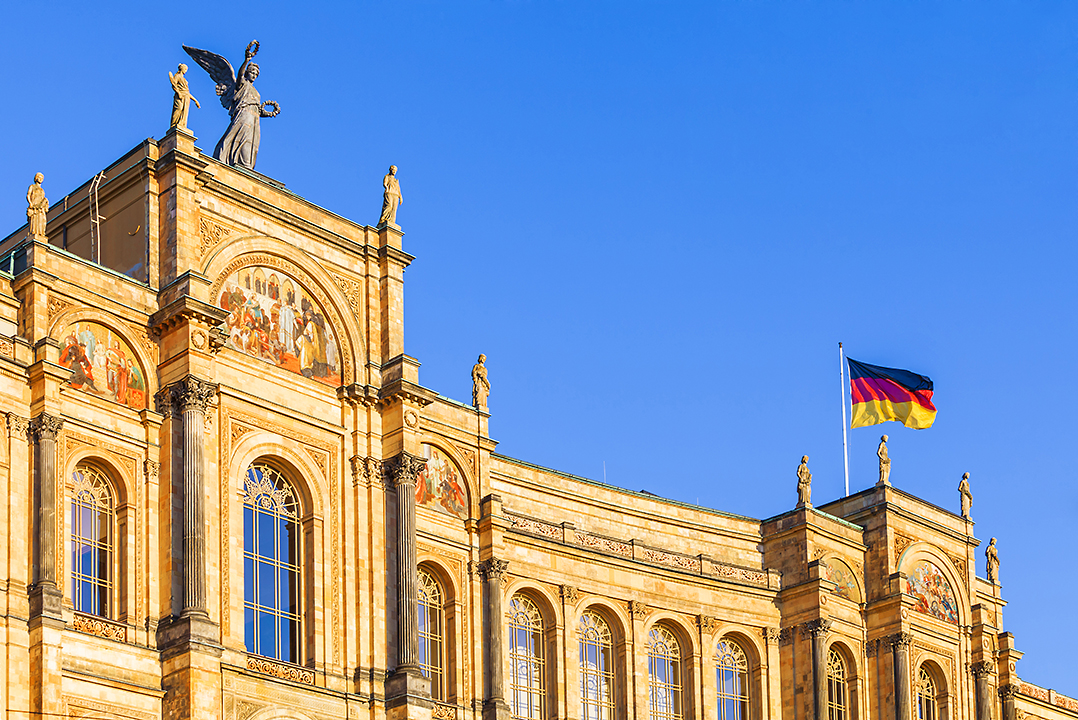
1Pfarrkirche St Anna im Lehel CHURCH
The rather pompous neo-Romanesque Pfarrkirche St Anna im Lehel arrived on the scene in 1892 when the Klosterkirche St Anna im Lehel became too small. Conceived by locally born architect Gabriel von Seidl, it’s worth a spin for the huge Byzantine-style painting behind the altar and little art nouveau touches throughout. (St-Anna-Platz 5; ![]() h8am-5pm Mon-Sat, to 8pm Sun;
h8am-5pm Mon-Sat, to 8pm Sun; ![]() jLehel,
jLehel, ![]() bLehel)
bLehel)
1Friedensengel STATUE
Just east of the Isar River, the Friedensengel (Angel of Peace) statue stands guard from its perch atop a 23m-high column. It commemorates the 1871 Treaty of Versailles, which ended the Franco-Prussian War, and the base contains some shimmering golden Roman-style mosaics. (Prinzregentenstrasse; ![]() gFriedensengel/Villa Stuck)
gFriedensengel/Villa Stuck)
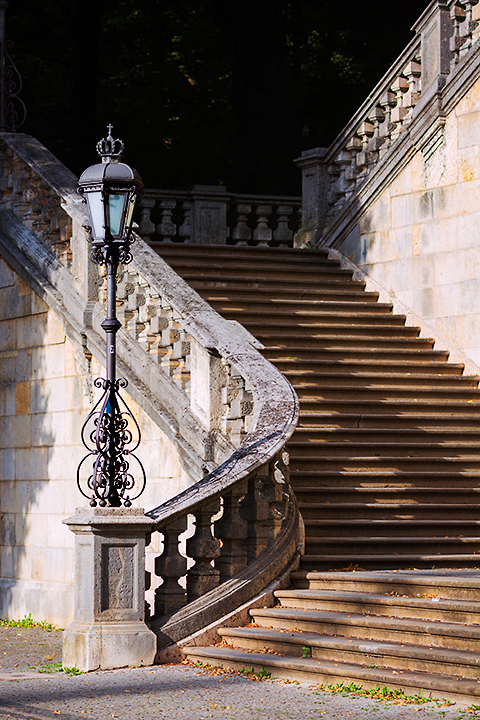
Best Munich Blogs
My Adventures in Munich (www.myadventuresinmunich.blogspot.com) Trials and tribulations of an expat in Munich.
Arts in Munich (www.artsinmunich.com) Covers culture, art, eating and wellness in the Bavarian capital and beyond.
Elsewhere and Here (www.elsewhereandhere.com) City tips from author and guide Monika Pfundmeier.
Around About Munich (www.aroundaboutmunich.de) Free-time family tips for the Munich area.
Move to Munich (www.movetomunich.com) Interesting blog on relocating and living in Munich.
Eating
5Wirtshaus in der Au BAVARIAN €€
The slogan of this Bavarian tavern is ‘Beer and dumplings since 1901’, and it’s this time-honoured staple – dumplings – that’s the speciality here (the tavern even runs a dumpling-making course in English). Once a brewery, the space-rich dining area has chunky tiled floors, a lofty ceiling and a crackling fireplace in winter. When spring springs, the beer garden fills. (![]() %089-448 1400; www.wirtshausinderau.de; Lilienstrasse 51; mains €10-22;
%089-448 1400; www.wirtshausinderau.de; Lilienstrasse 51; mains €10-22; ![]() h5pm-midnight Mon-Fri, from 10am Sat & Sun;
h5pm-midnight Mon-Fri, from 10am Sat & Sun; ![]() jDeutsches Museum)
jDeutsches Museum)
5Sir Tobi BAVARIAN €€
This Bavarian bistro serves delicious, slow-food versions of southern German and Austrian dishes in an environment of crisp white tablecloths and fresh flowers. The service here is particularly good. (![]() %089-3249 4825; www.sirtobi-muenchen.de; Sternstrasse 16; mains €9-20;
%089-3249 4825; www.sirtobi-muenchen.de; Sternstrasse 16; mains €9-20; ![]() h11.30am-3pm Mon-Fri, 5.30pm-midnight Thu-Sat;
h11.30am-3pm Mon-Fri, 5.30pm-midnight Thu-Sat; ![]() W;
W; ![]() jLehel)
jLehel)
5Fischhäusl SEAFOOD €€
Part of the food market on Wiener Platz, this kiosk with a few seats is one of the best spots in Munich to lunch on fish, which is prepared simply on a grill and served with salad, potatoes and white wine. (Wiener Platz; mains €7-15; ![]() h9.30am-6pm Tue-Fri, 9am-2.30pm Sat;
h9.30am-6pm Tue-Fri, 9am-2.30pm Sat; ![]() jWiener Platz)
jWiener Platz)

5Dreigroschenkeller BAVARIAN €€
A quirky, labyrinthine, brick-cellar pub with rooms – based on Bertolt Brecht’s Die Dreigroschenoper (The Threepenny Opera) – ranging from a prison cell to a red satiny salon. There are several types of beer to choose from and an extensive menu of hearty Bavarian favourites. (Lilienstrasse 2; mains €10-20; ![]() h5pm-1am Sun-Thu, to 3am Fri & Sat;
h5pm-1am Sun-Thu, to 3am Fri & Sat; ![]() jDeutsches Museum)
jDeutsches Museum)
5Swagat INDIAN €€
Swagat fills every nook of an intimate cellar space with Indian fabrics, cavorting Hindu gods and snow-white tablecloths. The curry is as hot as Bavarians can take it, and there’s plenty to please non-carnivores. (Prinzregentenplatz 13; mains €10.50-22.50; ![]() h11.30am-2.30pm & 5.30pm-1am;
h11.30am-2.30pm & 5.30pm-1am; ![]() v;
v; ![]() gPrinzregentenplatz,
gPrinzregentenplatz, ![]() XPrinzregentenplatz)
XPrinzregentenplatz)
5Showroom GASTRONOMY €€€
Andreas Schweiger’s crossover creations strike just the right balance between adventure and comfort, which is why his Michelin-starred restaurant is among the most respected in town. The finely crafted dishes on offer are beyond the means of most mortals, so this is definitely one for very special occasions. (![]() %089-4442 9082; Lilienstrasse 6; 5-course menu €115-135;
%089-4442 9082; Lilienstrasse 6; 5-course menu €115-135; ![]() h6pm-1am Mon-Fri;
h6pm-1am Mon-Fri; ![]() jDeutsches Museum)
jDeutsches Museum)

Drinking
6Hofbräukeller BEER HALL
One of Munich’s original beer halls, this wood-panelled, staunchly traditional tavern serves nine different types of the finest Hofbräu, including two alcohol-free versions and always a seasonal brew. Out the back is what was, many claim, Munich’s very first beer garden. (![]() %089-459 9250; www.hofbraeukeller.de; Wiener Platz;
%089-459 9250; www.hofbraeukeller.de; Wiener Platz; ![]() h10am-midnight;
h10am-midnight; ![]() jWiener Platz)
jWiener Platz)
6Biergarten Muffatwerk BEER GARDEN
Think of this one as a progressive beer garden with reggae instead of oompah, civilised imbibing instead of brainless guzzling, organic meats, fish and vegetables on the grill, and the option of chilling in lounge chairs. Opening hours are open-ended, meaning some very late finishes. (www.muffatwerk.de; Zellstrasse 4; ![]() hfrom noon mid-Mar–mid-Oct;
hfrom noon mid-Mar–mid-Oct; ![]() jAm Gasteig)
jAm Gasteig)
Symphonie Orchestra
Charismatic Lithuanian maestro Mariss Jansons has rejuvenated the playlist of the BR-Symphonieorchester (![]() %089-590 001; www.br-so.com) and it often performs with its choir at such venues as the Gasteig and the Prinzregententheater.
%089-590 001; www.br-so.com) and it often performs with its choir at such venues as the Gasteig and the Prinzregententheater.
Strong Beer Time
The ‘Strong Beer Time’ originally developed to make the fasting season of Lent more bearable. It’s thought monks brewed more potent beer at this time to make up for the meagre rations they consumed, and the locals were more than willing to join them.
Today the Starkbierzeit has turned into another mini-Oktoberfest (for beer fans it conveniently falls between Oktoberfest and the opening of the city’s beer gardens), celebrated with beverages containing almost 8% alcohol. The most famous of these is Salvator, pumped with abandon by the Paulaner brewery.
To join in the inebriated revelry of the Starkbierzeit, head to the Augustinerkeller, Nockherberg and the Löwenbräukeller.
Entertainment
3Jazzclub Unterfahrt im Einstein LIVE MUSIC
Join a diverse crowd at this long-established, intimate club for a mixed bag of acts ranging from old bebop to edgy experimental. The Sunday open-jam session is legendary. (![]() %089-448 2794; www.unterfahrt.de; Einsteinstrasse 42;
%089-448 2794; www.unterfahrt.de; Einsteinstrasse 42; ![]() hfrom 9pm;
hfrom 9pm; ![]() XMax-Weber-Platz)
XMax-Weber-Platz)
3Museum-Lichtspiele CINEMA
Cult cinema with wacky interior and screenings of the Rocky Horror Picture Show (11.10pm Friday and Saturday nights). Shows English-language movies. (![]() %089-482 403; www.museum-lichtspiele.de; Lilienstrasse 2;
%089-482 403; www.museum-lichtspiele.de; Lilienstrasse 2; ![]() jDeutsches Museum)
jDeutsches Museum)
3Münchner Philharmoniker CLASSICAL MUSIC
Munich’s premier orchestra regularly performs at the Gasteig Cultural Centre. Book tickets early, as these performances usually sell out. (![]() %089-480 985 500; www.mphil.de; Rosenheimer Strasse 5;
%089-480 985 500; www.mphil.de; Rosenheimer Strasse 5; ![]() hmid-Sep–Jun;
hmid-Sep–Jun; ![]() jAm Gasteig)
jAm Gasteig)
3GOP Varieté Theater THEATRE
Hosts a real jumble of acts and shows, from magicians to light comedies to musicals. (![]() %089-210 288 444; www.variete.de; Maximilianstrasse 47;
%089-210 288 444; www.variete.de; Maximilianstrasse 47; ![]() jMaxmonument)
jMaxmonument)